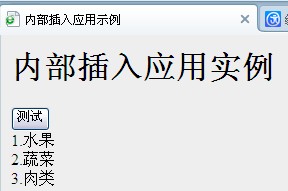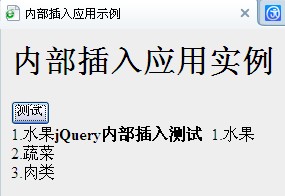jQuery操作DOM十分方便,有許多現成的方法。
以下為各種方法的示例和代碼。
1.刪除操作
(1)remove()
$(selector).remove([selector])
$("#div3").remove(); //刪除 id 為 div3 的 div 標簽
$("div").remove("#div3"); //刪除 div 標簽中 id 為 "div3" 的標簽
(2)detach()
$(selector).detach([selector])
$("#div3").detach(); //刪除 id 為 div3 的 div 標簽
$("div").detach("#div3"); //刪除 div 標簽中 id 為 "div3" 的標簽
(3)empty()
$(selector).empty()
$("#div3").empty(); //刪除 id 為 div3 的節點的所有子節點
總結:remove 方法和 detach 方法的返回值均為被刪除的jQuery節點對象,不同的是,前者指保留該對象節點本身,其他綁定的事件及附加的數據等都會被移除。而後者全部保留。empty 方法則是將指定節點的所有子節點刪除,本身保留。
2.復制節點 clone()
$(selector).clone([true]);
帶true參數則復制出來的節點具備原節點所綁定的事件處理程序。
3.替換節點
(1)replaceAll()
$(content).replaceAll(selector);
(2)replaceWith()
$(selector).repalceWith(content);
這兩種方法在使用時效果完全相同,都是用 content 代替 selector.
4.內部插入
內部插入是將content插入到selector節點內部,包括內部的頭部和尾部。插入後的節點與原節點是父子關系。
(1)append()
將content添加到seletor內部的頭部。
$(selector).append(content);
$(selector).append(function(index [,html]){...});
如果要獲取selector的元素index及html內容,則采用第二種方法。調用的實例如下(html是可選參數):
<!DOCTYPE HTML PUBLIC "-//W3C//DTD HTML 4.01 Transitional//EN">
<html>
<head>
<meta http-equiv="Content-Type" content="text/html; charset=utf-8" />
<script src="../js/jquery-1.7.2.js" type="text/javascript"></script>
<title>內部插入應用示例</title>
<script language="javascript" type="text/javascript">
$(document).ready(function(){
$("#btn").click(function(){
//方法1 用 eq() 選擇器找到指定節點
//$("div:eq(1)").append("<b>jQuery內部插入測試</b>");
//方法2 用函數的參數index索引值找到指定節點
$("div").append(function(index, html){
if(index == 1){
return "<b>jQuery內部插入測試</b>" + " " + html;
}
});
});
});
</script>
</head>
<body bgcolor="#EEEEEE">
<h1>內部插入應用實例</h1>
<div>
<button id="btn">測試</button>
<div id="div1">1.水果</div>
<div id="div2">2.蔬菜</div>
<div id="div3">3.肉類</div>
</div>
</body>
</html>
運行及點擊測試按鈕之後的效果如下:


(2)appendTo()
$(content).appendTo(selector);
(3)prepend()
將content添加到seletor內部的尾部。
$(selector).prepend(content);
$(selector).prepend(function(index [,html]){...});
(4)prependTo()
$(content).prependTo(selector);
前兩種方法效果相同,後兩種方法效果相同。
5.外部插入
外部插入是將content插入到selector節點外部,包括selector節點的前面和後面。插入後的節點與原節點是兄弟關系。
(1)after()
$(selector).after(content);
$(selector).after(function(index [,html]){...});
(2)insetAfter()
$(content).insertAfter(selector);
(3)before()
$(selector).before(content);
$(selector).before(function(index [,html]){...});
(4)insertBefore()
$(content).insertBefore(selector);
使用方法與內部插入類似。
6.包裹操作
(1)wrap()
$(selector).wrap(wrapper);
$(selector).wrap(function(){...});
下面代碼中的四種方法效果相同:
$(document).ready(function(){
$("#btn").click(function(){
var newNode = $("<b></b>");
//方法1
//$("#div2").wrap(newNode);
//方法2
//$("#div2").wrap("<b></b>");
//方法3
//$("#div2").wrap(document.createElement("b"));
//方法4
$("#div2").wrap(function(){
return "<b></b>";
});
});
});
(2)unwrap()
$(selector).unwrap();
(3)wrapAll()
$(selector).wrapAll(wrapper);
(4)wrapInner()
$(selector).wrapInner(wrapper);
$(selector).wrapInner(function(){...});
總結:wrap() 和 wrapInner() 的顯示效果相同,不同的是前者為 seletor 添加了父節點,而後者為 selector 添加了子節點。
wrap() 和 wrapAll() 顯示效果也相同,不同的是前者為 seletor 中的每一個子元素均添加父節點,而後者為整個 seletor 只添加一個父節點